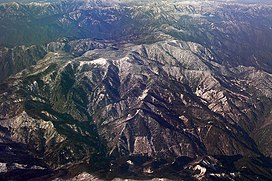| Ōdaigahara-san | |
|---|---|
| 大台ヶ原山 | |
 Mount Odaigahara's massif from the southeast | |
| Highest point | |
| Elevation | 1,695 m (5,561 ft) |
| Coordinates | 34°07′N 136°02′E / 34.11°N 136.03°E |
| Geography | |
| Climbing | |
| Easiest route | Hiking |
Ōdaigahara-san or Ōdaigahara-yama (大台ヶ原山), also Hinode-ga-take or Hide-ga-take (日出ヶ岳) is a mountain in the Daikō Mountain Range on the border between the prefectures of Mie and Nara, Japan. Its top is the highest point in Mie at 1,695 metres (5,561 ft). Walking trails from the Nara side start from a car park at about 1,400 metres. The mountain is famous for wild deer, and also for wild birds, especially wrens and Japanese robins, as well as treecreepers and woodpeckers. In 1980, an area of 36,000 hectares in the region of Mount Ōdaigahara and Mount Ōmine was designated a UNESCO Man and the Biosphere Reserve.[1]
The mountain was also selected by the Tokyo Nichi Nichi Shimbun and Osaka Mainichi Shimbun newspapers[2] as one of the 100 Landscapes of Japan in 1927. It was referenced on American indie folk band Fleet Foxes's 2017 song "Third of May / Ōdaigahara".


See also
[edit]References
[edit]- ^ "Biosphere Reserve Information - Mount Odaigahara and Mount Omine". UNESCO. Retrieved 29 April 2011.
- ^ "日本八景(昭和2年)の選定内容" (PDF). Ministry of the Environment. Retrieved 17 March 2011.
External links
[edit]- Odaigahara - Kamikitayama Village (Japanese)


Well, that’s interesting to know that Psilotum nudum are known as whisk ferns. Psilotum nudum is the commoner species of the two. While the P. flaccidum is a rare species and is found in the tropical islands. Both the species are usually epiphytic in habit and grow upon tree ferns. These species may also be terrestrial and grow in humus or in the crevices of the rocks.
View the detailed Guide of Psilotum nudum: Detailed Study Of Psilotum Nudum (Whisk Fern), Classification, Anatomy, Reproduction